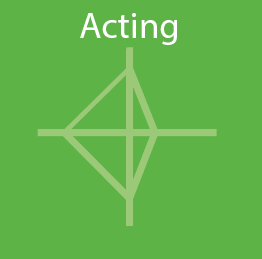Learning style describes the unique ways individuals spiral through the learning cycle based on their preference for the four different learning modes. Because of one’s genetic makeup, particular life experiences, and the demands of the present environment, a preferred way of choosing among these four learning modes is developed.
Data from empirical and clinical studies over the years has shown that original four learning style types—Accommodating, Assimilating, Converging and Diverging— can be refined further into a nine style typology that better defines the unique patterns of individual learning styles and reduces the confusions introduced by borderline cases in the old 4 style typology.
With feedback from users, Kolb first began noticing a fifth “balancing” style describing users who scored at the centre of the Learning
Style grid.
The new KLSI (Kolb Learning Style Inventory) 4.0 introduces these nine style types by moving from a 4 pixel to 9-pixel resolution of learning style types as described below. The learning style types can be systematically arranged on a two-dimensional learning space defined by Abstract Conceptualization-Concrete Experience and Active Experimentation-Reflective Observation.
This space, including a description of the distinguishing kite shape of each style, is depicted in the figure below:


The Initiating style is characterized by the ability to initiate action in order to deal with experiences and situations. It involves active experimentation and concrete
experience.
The Initiating style people: They thrive in dynamic learning spaces where they can work with others to get assignments done, to set goals and to try out different approaches to completing a project. They prefer teachers who take the role of coach or mentor in helping them learn from their life experiences.
Learning Strengths
Learning Challenges

The Experiencing style is characterized by the ability to find meaning from deep involvement in experience. It draws on concrete experience while balancing active experimentation and reflective observation.
The Experiencing style people: They prefer learning spaces rich in interactions and ongoing communications with their friends and co-workers. While they may enjoy working in groups, they also need time to work alone to get things done. It is important that they receive constructive feedback on their
progress at work and in their personal life. It is important for them to have a personal relationship with their teacher.
Learning Strengths
Learning Challenges

The Imagining style is characterized by the ability to imagine possibilities by observing and reflecting on experiences. It combines the learning steps of concrete experience and reflective observation.
The Imagining style people: They like working in groups where there is open and free flowing conversation where they can gather information, listen with an open mind, and receiving personalized feed-back. They may enjoy situations that call for generating a wide range of ideas, such as brainstorming sessions. They like teachers who take a facilitating role and are sensitive and creative.
Learning Strengths
Learning Challenges

The Reflecting style is characterized by the ability to connect experience and ideas through sustained reflection. It draws on reflective observation while ba-
lancing concrete experience and abstract conceptualization.
The Reflecting style people: They thrive in learning spaces rich in dialogue and discussions, but they are also comfortable learning from lectures, independent projects, and from readings. Because of their preference for deep reflection, they may also need time to reflect and make sense of their experience on their own. They value teachers who provide opportunities for individualand group reflection and who are open to exploring ideas.
Learning Strengths
Learning Challenges

The Analysing style is characterized by the ability to integrate and systematize ideas through reflection. It combines reflective observation and abstract con-
ceptualization.
The Analysing style people: They thrive in learning spaces where they can use and develop their analytical and conceptual skills. They may prefer lectures, readings, exploring analytical models, and having time to think things through. They would rather work alone than in groups. They prefer teachers who model their thinking and analysis process in their lectures and interactions with them.
Learning Strengths
Learning Challenges

The Thinking style is characterized by the capacity for disciplined involvement in abstract and logical reasoning. It draws on abstract conceptualization while
balancing active experimentation and reflective observation.
The Thinking style people: They may learn best in well-structured learning spaces with clear directions and learning agendas. They also thrive in environments in which they can design or conduct experiments or manipulate data. They may prefer to work alone and need time to think things through. A teacher’s expertise in their field is of primary importance to them.
Learning Strengths
Learning Challenges

The Deciding style is characterized by the ability to use theories and models to decide on problem solutions and courses of action. it combines abstract concep-
tualization and active experimentation.
The Deciding style people: They may learn best in learning spaces where they can experiment with new ideas, simulations, laboratory assignments, and practical applications. They prefer teachers who set clear standards and goals and evaluate with problems and questions that have right or wrong answers.
Learning Strengths
Learning Challenges

The Acting style is characterized by a strong motivation for goal directed action that integrates people and tasks. It draws on active experimentation while ba-
lancing concrete experience and abstract conceptualization.
The Acting style people: They learn best by on the job learning through discussions with colleagues and working in teams. They prefer teachers with practical real world experience that they can emulate.
Learning Strengths
Learning Challenges

The Balancing style is characterized by the ability to adapt; weighing the pros and cons of acting versus reflecting and experiencing versus thinking. It balances
concrete experience, abstract conceptualization, active experimentation and reflective observation.
The Balancing style people: They tend to be more satisfied in learning environments where they can use all four learning modes: learning from lectures, discussions groups, brainstorming sessions, labs and on-the-job learning. Because they are able to adapt to the different learning environments, they
can learn from teachers with different teaching approaches.
Learning Strengths
Learning Challenges